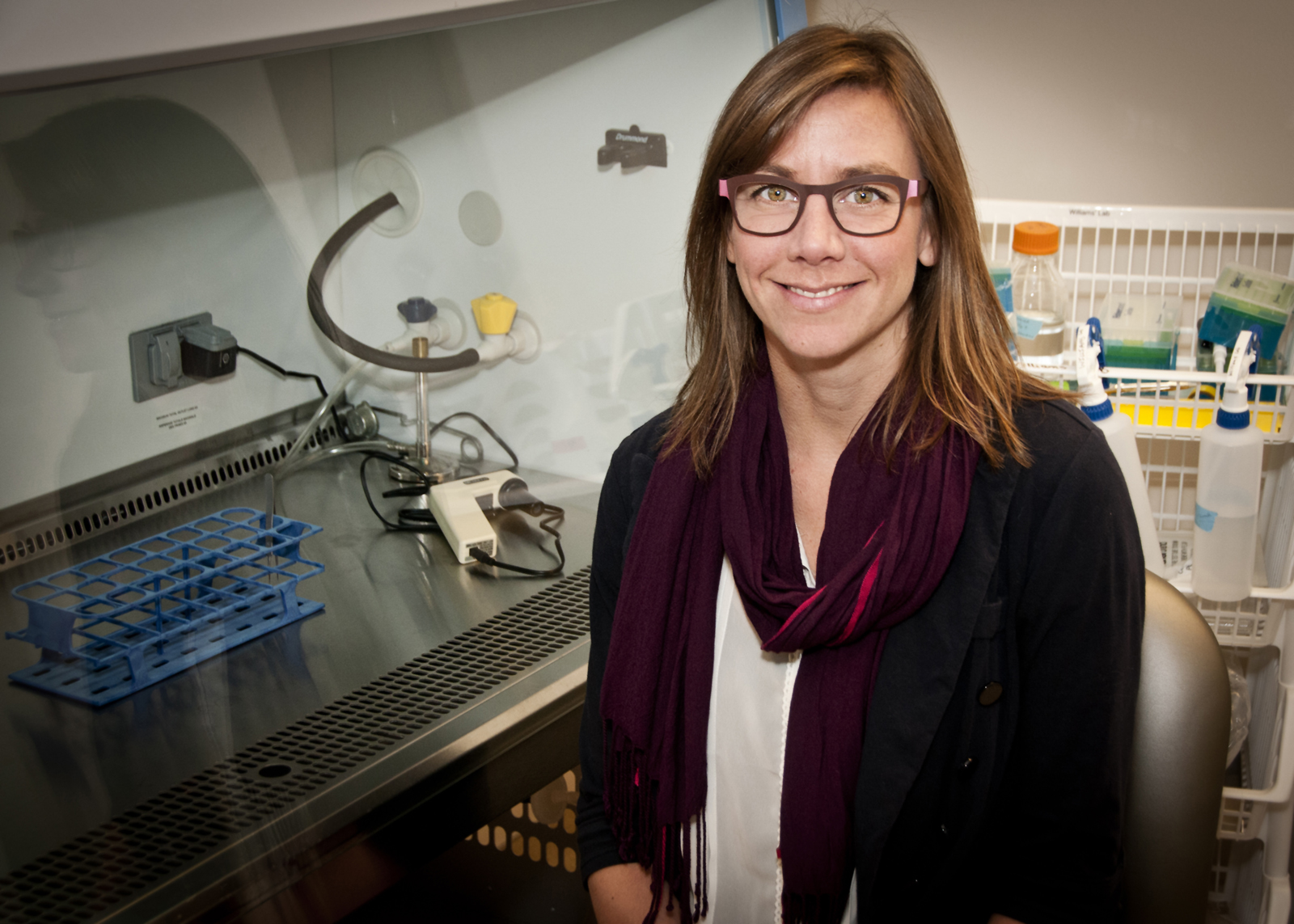Megan Williams
Associate Professor of Neurobiology
B.S. Juniata College
Ph.D. University of California, Santa Cruz
Megan Williams' Lab Page
Molecular Biology Program
Neurobiology, Molecular mechanisms of synapse formation
Research
Proper function of the brain depends on precise synaptic connections that arise during development. This feature, known as synaptic specificity, requires that neurons recognize correct synaptic partners, often among many cell types, and then develop appropriate types of synapses. Synaptic defects are thought to underlie many types of mental and cognitive dysfunction, including epilepsy and autism spectrum disorders and despite the importance of specific neural connections, there is very little known about molecular mechanisms that regulate the formation of synaptic specificity in the mammalian brain.
The overall goals of my lab are to:
- identify key molecules required for the development of synaptic specificity
- investigate the molecular mechanisms by which they mediate synapse formation
- understand how defects in synaptic specificity cause neurological disorders
To accomplish these goals, we use the rodent hippocampus as a model system. The hippocampus is an important relay center for cognition and although its connectivity patterns are well understood, very little is known about how specific connections develop and what the consequences are of a mis-wired circuit on learning and memory. Surprisingly, dissociated hippocampal neurons retain many aspects of specificity and largely connect in the culture dish as they do in the brain. Cultured neurons are conducive to genetic and pharmacological manipulations and therefore, provide an unprecedented tool for investigating the molecular basis of synaptic specificity. Cultured neurons are not, however, a complete substitute for the brain. Therefore, we also use a variety of molecular and imaging techniques including transgenic mice, viruses, in utero electroporation, electron and confocal microscopy to investigate how the molecules and mechanisms that we identify in culture function in the intact brain during development, disease, and behavior.
References
- Das S, Chen D, Callor WB, Christensen E, Coon H, Williams ME. DiI-mediated analysis of presynaptic and postsynaptic structures in human post-mortem brain tissue. J. Comp. Neurology 2019.
- Basu R, Duan X, Taylor MR, Martin A, Muralidhar S, Wang Y, Gangi-Wellman L, Das SC, Yamagata M, West PJ, Sanes JR, Williams ME. Heterophilic Type II cadherins are required for high magnitude synaptic potentiation in the hippocampus. Neuron. 2017 Sept 27.
-
Martin EA, Woodruff D, Rawson R, Williams ME (2017) Examining hippocampal mossy fiber synapses by 3D electron microscopy in wildtype and Kirrel3 knockout mice. eNeuro, May 22
-
Rawson R, Martin EA, Williams ME (2017) Mechanisms of input and output synaptic specificity: Finding partners, building synapses, and fine-tuning communication. Current Opinion in Neurobiology, 45:39-44
-
Martin E A*, Muralidhar S*, Wang Z, Cervantes DC, Basu R, Taylor MR, Hunter J, Cutforth T, Wilke SA, Ghosh A, Williams ME (2015) The intellectual disability gene Kirrel3 regulates target-specific mossy fiber synapse development in the hippocampus. eLife, 4:e09395
- Viswanathan S, Williams ME, Bloss EB, Stasevich TJ, Speer CM, Nern A, Pfeiffer BD, Hooks BM, Li WP, English BP, Tian T, Henry GL, Macklin JJ, Patel R, Gerfen CR, Zhuang X, Wang Y, Rubin GM, Looger LL (2015) High-performance probes for light and electron microscopy. Nature Methods, 12(6):568-76
- Basu R, Taylor MR, Williams ME (2015) The classic cadherins in synaptic specificity. Cell Adhesion & Migration, 9(3):193-201
- Wilke SA, Hall BJ, Antonios J, DeNardo L, Otto S, Yuan B, Chen F, Robbins EM, Tiglio K, Williams ME, Qiu Z, Biederer T, Ghosh A (2012) NeuroD2 Regulates Development of Hippocampal Mossy Fiber Synapses. Neural Development, 7:9
- Williams ME, Wilke SA, Daggett A, Davis E, Otto S, Ripley B, Bushong EA, Ellisman M, Klein G, Ghosh A (2011) Cadherin-9 regulates input-specific synaptic differentiation in the developing hippocampus. Neuron, 71:640-655
- Ripley B*, Otto S*, Tiglio K, Williams ME, Ghosh A (2011) Regulation of synaptic stability by AMPA receptor reverse signaling. PNAS, 108(1):367-72
- Williams ME, DeWit J, Ghosh A (2010) Molecular mechanisms of synaptic specificity in developing neural circuits. Neuron, 68(1);9-18 (Review)
- Loomis WF, Behrens MM, Williams ME, Anjard C (2010) Pregnenolone sulfate and cortisol induce secretion of acyl coa binding protein and its conversion into endozepines from astrocytes. J Biol Chem, 285:21359-65
- Stebbins, JL, Zhang Z, Chen J, Wu B, Emdadi A, Williams ME, Cashman J, and Pellecchia M (2007) Nuclear Magnetic Resonance fragment-based identification of novel FK506-binding–protein 12 inhibitors. J Med Chem, 50(26):6607-17
- Williams ME*, Lu X*, McKenna WL*, Washington R, Boyette A, Strickland P, Dillon A, Kaprielian Z, Tessier-Lavigne M, Hinck L (2006) UNC5A promotes neuronal apoptosis during spinal cord development independent of netrin-1. Nature Neuroscience, 9(8):996-8
- Williams ME*, Wu S*, McKenna W*, Hinck L (2003) Surface expression of the netrin receptor UNC5H1 is regulated by a PICK1/PKC dependent mechanism. J Neuroscience, 23:11279-88
- Williams ME, Strickland P, Watanabe K, and Hinck L (2003) UNC5H1 induces apoptosis via its juxtamembrane region through an interaction with NRAGE. J Biol Chem, 278:17483-90
*denotes co-authorship
